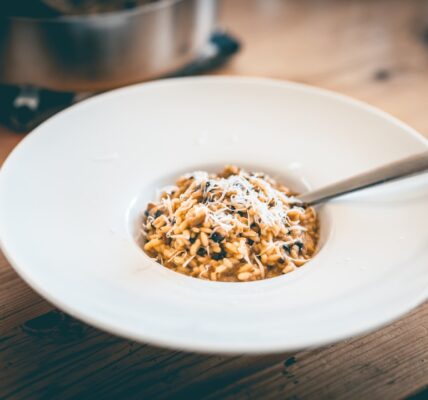Grilled Asian Halibut with Soy Ginger Glaze is a dish that combines halibut with Asian-inspired flavors. The fish is marinated in a mixture of soy sauce, ginger, garlic, and honey, creating a flavorful glaze. When grilled, the halibut develops a smoky exterior while remaining tender inside.
The glaze caramelizes during cooking, forming a crust that enhances the fish’s natural flavor. To prepare this dish, create a marinade by mixing soy sauce, grated ginger, minced garlic, honey, and rice vinegar. Marinate halibut fillets for at least 30 minutes.
Grill the fish on medium-high heat for 4-5 minutes per side, or until it flakes easily. Baste with remaining marinade while cooking to build up the glaze. Serve garnished with green onions and a squeeze of lime juice.
This recipe offers a balance of flavors and textures, making it suitable for various occasions, from summer barbecues to healthy dinners. Its combination of tender fish and bold Asian flavors has made it popular among both home cooks and professional chefs.
Key Takeaways
- Grilled Asian Halibut with Soy Ginger Glaze: A simple and flavorful way to prepare halibut with a delicious soy ginger glaze.
- Asian Halibut Curry with Coconut Milk and Lemongrass: A creamy and aromatic curry dish that combines the delicate flavor of halibut with coconut milk and lemongrass.
- Pan-Seared Asian Halibut with Spicy Thai Basil Sauce: A spicy and savory dish that pairs perfectly with the tender and flaky halibut.
- Baked Asian Halibut with Miso Glaze and Green Onions: A unique and umami-rich way to prepare halibut with a miso glaze and green onions.
- Steamed Asian Halibut with Ginger and Scallions: A light and healthy option that highlights the natural flavors of halibut with ginger and scallions.
Asian Halibut Curry with Coconut Milk and Lemongrass
Flavor Profile and Pairing Suggestions
This dish is perfect for those who enjoy bold and spicy flavors, as well as those who appreciate the comforting creaminess of coconut milk-based curries. To make Asian Halibut Curry with Coconut Milk and Lemongrass, start by preparing the curry base. In a large skillet or wok, heat some oil over medium heat and add minced lemongrass, ginger, garlic, and red curry paste.
Preparing the Curry and Cooking the Halibut
Sauté the aromatics until fragrant, then pour in a can of coconut milk and stir to combine. Allow the mixture to simmer for a few minutes to let the flavors meld together. Gently place the halibut fillets into the curry sauce, making sure they are submerged in the liquid. Cover the skillet and let the fish cook for 8-10 minutes, or until it is opaque and flaky. Once done, garnish the curry with fresh cilantro and a squeeze of lime juice for a burst of freshness. Serve the Asian Halibut Curry with Coconut Milk and Lemongrass over steamed jasmine rice or with warm naan bread for a complete and satisfying meal.
A Symphony of Flavors and Aromatic Delight
Asian Halibut Curry with Coconut Milk and Lemongrass is a dish that will transport your taste buds to the vibrant streets of Southeast Asia. The combination of tender halibut and fragrant curry sauce creates a symphony of flavors that will leave you craving for more. Whether you’re an adventurous foodie or someone who enjoys comforting and aromatic dishes, this Asian-inspired curry is sure to become a new favorite in your recipe repertoire. With its exotic ingredients and tantalizing aroma, Asian Halibut Curry with Coconut Milk and Lemongrass is a must-try for anyone looking to elevate their seafood cooking game.
Pan-Seared Asian Halibut with Spicy Thai Basil Sauce

Pan-Seared Asian Halibut with Spicy Thai Basil Sauce is a tantalizing dish that brings together the delicate flavor of halibut with the bold and aromatic taste of Thai cuisine. The halibut fillets are seasoned with a blend of spices and then seared to perfection, resulting in a crispy and golden-brown crust that adds texture to the dish. The spicy Thai basil sauce is made with fresh basil, chilies, garlic, and fish sauce, creating a pungent and savory condiment that perfectly complements the tender fish.
This dish is perfect for those who enjoy bold and spicy flavors, as well as those who appreciate the fragrant and herbaceous notes of Thai cuisine. To make Pan-Seared Asian Halibut with Spicy Thai Basil Sauce, start by seasoning the halibut fillets with salt, pepper, and a pinch of chili flakes. Heat some oil in a skillet over medium-high heat and carefully place the seasoned halibut in the pan.
Sear the fish for 3-4 minutes on each side, or until it develops a crispy crust and is cooked through. While the halibut is cooking, prepare the spicy Thai basil sauce by blending together fresh basil leaves, red chilies, garlic, fish sauce, and a splash of lime juice until smooth. Once the halibut is done, transfer it to a serving platter and spoon the spicy Thai basil sauce over the top.
Garnish with additional basil leaves and sliced red chilies for an extra pop of color and flavor. Pan-Seared Asian Halibut with Spicy Thai Basil Sauce is a dish that will awaken your senses with its vibrant colors and bold flavors. The combination of tender halibut and pungent Thai basil sauce creates an explosion of taste that will leave you wanting more.
Whether you’re an avid fan of Thai cuisine or someone looking to explore new flavor profiles, this pan-seared halibut dish is sure to become a new favorite in your recipe collection. With its crispy exterior and aromatic sauce, Pan-Seared Asian Halibut with Spicy Thai Basil Sauce is a must-try for anyone looking to elevate their seafood cooking game.
Baked Asian Halibut with Miso Glaze and Green Onions
| Ingredients | Quantity |
|---|---|
| Halibut fillets | 4 |
| Miso paste | 3 tablespoons |
| Soy sauce | 2 tablespoons |
| Rice vinegar | 1 tablespoon |
| Green onions, chopped | 3 |
| Garlic, minced | 2 cloves |
| Ginger, grated | 1 teaspoon |
| Sesame oil | 1 teaspoon |
| Sesame seeds | 1 tablespoon |
| Green onions, sliced (for garnish) | 1 |
Baked Asian Halibut with Miso Glaze and Green Onions is an elegant dish that combines the delicate flavor of halibut with the rich umami taste of miso glaze. The halibut fillets are generously brushed with a mixture of miso paste, mirin, soy sauce, and honey before being baked to perfection, resulting in a caramelized and flavorful crust that enhances the natural sweetness of the fish. The green onions add a pop of freshness and color to the dish, creating a beautiful contrast to the rich miso glaze.
This dish is perfect for those who enjoy complex flavors and appreciate the depth of umami in their meals. To make Baked Asian Halibut with Miso Glaze and Green Onions, start by preheating your oven to 400°F (200°C). In a small bowl, whisk together miso paste, mirin, soy sauce, honey, and a splash of rice vinegar until smooth.
Place the halibut fillets on a parchment-lined baking sheet and generously brush them with the miso glaze. Bake the halibut for 12-15 minutes, or until it is opaque and easily flakes with a fork. While the fish is baking, thinly slice some green onions on the diagonal for garnish.
Once done, remove the halibut from the oven and sprinkle it with the sliced green onions. Serve the Baked Asian Halibut with Miso Glaze and Green Onions over steamed white rice or alongside sautéed vegetables for a complete and satisfying meal. Baked Asian Halibut with Miso Glaze and Green Onions is a dish that will impress even the most discerning palates with its complex flavors and elegant presentation.
The combination of tender halibut and rich miso glaze creates a harmonious balance that will leave you craving for more. Whether you’re hosting a dinner party or simply looking for an indulgent yet healthy meal option, this baked halibut dish is sure to become a new favorite in your recipe repertoire. With its caramelized exterior and umami-rich glaze, Baked Asian Halibut with Miso Glaze and Green Onions is a must-try for anyone looking to elevate their seafood cooking game.
Steamed Asian Halibut with Ginger and Scallions
Steamed Asian Halibut with Ginger and Scallions is a light yet flavorful dish that showcases the delicate taste of halibut while infusing it with aromatic ginger and scallions. The halibut fillets are gently steamed until they are tender and flaky, allowing them to absorb all the fragrant flavors from the ginger-infused broth. The addition of scallions adds a pop of freshness and color to the dish, creating a beautiful contrast to the mild sweetness of the fish.
This dish is perfect for those who enjoy clean and simple flavors as well as those who appreciate healthy cooking techniques. To make Steamed Asian Halibut with Ginger and Scallions, start by preparing the steaming liquid. In a large wok or steaming pot, bring some water to a simmer over medium heat.
Add thinly sliced ginger and scallions to infuse the water with their flavors. Place a steaming rack in the wok or pot, making sure it sits above the water level. Season the halibut fillets with salt and pepper before placing them on the steaming rack.
Cover the wok or pot with a lid and steam the fish for 8-10 minutes, or until it is opaque and easily flakes with a fork. Once done, carefully transfer the steamed halibut to a serving platter using a spatula. Garnish with additional sliced scallions for an extra burst of freshness.
Steamed Asian Halibut with Ginger and Scallions is a dish that celebrates simplicity while delivering maximum flavor. The combination of tender halibut and aromatic ginger-infused broth creates an elegant yet understated dish that will leave you feeling satisfied yet light on your feet. Whether you’re looking for a healthy meal option or simply want to showcase the natural sweetness of fresh seafood, this steamed halibut dish is sure to become a new favorite in your recipe collection.
With its clean flavors and delicate preparation method, Steamed Asian Halibut with Ginger and Scallions is a must-try for anyone looking to elevate their seafood cooking game.
Asian Halibut Tacos with Mango Salsa and Sriracha Mayo

The Perfect Blend of Flavors
The halibut fillets are seasoned with a blend of spices before being pan-seared to perfection, resulting in tender yet crispy fish that pairs perfectly with soft tortillas. The mango salsa adds sweetness and freshness to each bite while the sriracha mayo provides a creamy yet spicy kick that ties everything together.
Preparing the Dish
To make Asian Halibut Tacos with Mango Salsa and Sriracha Mayo, start by seasoning the halibut fillets with salt, pepper, cumin, paprika, and garlic powder. Heat some oil in a skillet over medium-high heat before carefully placing the seasoned halibut in the pan. Sear the fish for 3-4 minutes on each side until it develops a crispy crust while remaining tender on the inside. While the halibut is cooking, prepare the mango salsa by combining diced mangoes, red onion, cilantro, lime juice, salt, and pepper in a bowl. In another bowl, mix together mayonnaise and sriracha sauce to create the spicy mayo.
Assembling the Tacos
Once done, warm up some tortillas in a dry skillet before assembling your tacos by placing pieces of pan-seared halibut on each tortilla along with mango salsa and drizzling sriracha mayo on top. Asian Halibut Tacos with Mango Salsa and Sriracha Mayo are an explosion of flavors that will take your taste buds on an unforgettable journey.
A Must-Try Recipe
Whether you’re hosting a casual dinner party or simply looking for an exciting twist on taco night, this Asian-inspired taco dish is sure to become a new favorite in your recipe repertoire. With its crispy fish and vibrant toppings, Asian Halibut Tacos with Mango Salsa and Sriracha Mayo are a must-try for anyone looking to elevate their seafood cooking game.
Stir-Fried Asian Halibut with Vegetables and Teriyaki Sauce
Stir-Fried Asian Halibut with Vegetables and Teriyaki Sauce is an enticing dish that brings together tender pieces of halibut with crisp vegetables in a savory teriyaki glaze. The halibut is quickly stir-fried until it develops a golden-brown crust while remaining moist on the inside before being tossed in an umami-rich teriyaki sauce along with colorful vegetables such as bell peppers, snap peas, carrots, and broccoli. This dish is perfect for those who enjoy quick yet flavorful meals as well as those who appreciate balanced combinations of protein and vegetables.
To make Stir-Fried Asian Halibut with Vegetables and Teriyaki Sauce, start by preparing your teriyaki sauce by combining soy sauce, mirin, brown sugar, grated ginger, minced garlic, cornstarch slurry in a small bowl before setting it aside. Heat
If you’re looking for more Asian-inspired recipes, be sure to check out this article on divinelyhers.com for some delicious and creative ideas for incorporating Asian flavors into your cooking. Whether you’re a fan of spicy Szechuan dishes or prefer the delicate flavors of Japanese cuisine, you’re sure to find something to inspire your next meal.
FAQs
What is Asian halibut?
Asian halibut is a type of flatfish that is commonly found in the waters of the North Pacific Ocean. It is known for its mild, sweet flavor and firm, flaky texture, making it a popular choice for cooking.
What are some popular Asian halibut recipes?
Some popular Asian halibut recipes include grilled halibut with soy ginger marinade, miso-glazed halibut, halibut curry, and steamed halibut with ginger and scallions. These recipes often incorporate Asian flavors such as soy sauce, ginger, garlic, and sesame oil.
How is Asian halibut typically cooked?
Asian halibut can be cooked using a variety of methods, including grilling, baking, steaming, and pan-searing. It is often marinated in flavorful sauces or seasonings to enhance its natural taste.
What are some common ingredients used in Asian halibut recipes?
Common ingredients used in Asian halibut recipes include soy sauce, ginger, garlic, sesame oil, scallions, cilantro, miso paste, curry paste, and coconut milk. These ingredients help to infuse the fish with Asian flavors and aromas.
Are there any specific cooking tips for preparing Asian halibut?
When cooking Asian halibut, it is important to not overcook the fish, as it can become dry and lose its delicate texture. It is also recommended to use fresh ingredients and to marinate the fish for a period of time to allow the flavors to fully develop.




